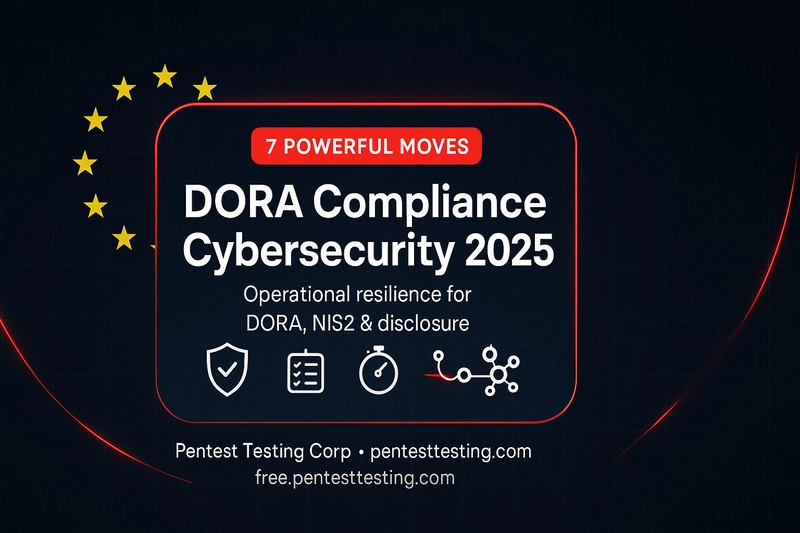TL;DR (for busy leaders & builders)
- Why now: DORA took effect on Jan 17, 2025 and regulators worldwide are maturing cyber policy. Translation: resilience is a business mandate, not a security afterthought.
- What changes: Tighter incident reporting windows, third-party/vendor accountability, supply-chain governance, and proof of operational resilience—with real evidence.
- How to win: Ship automation for asset inventory, SBOM, config hardening, vendor risk scoring, incident simulations, and restore drills. Tie these to your risk register and board reporting.
- Quick start: Run an external snapshot of your site/app with our free Website Vulnerability Scanner and fold the results into your risk backlog.
Pentest Testing Corp Blog • Risk Assessment Services • Remediation Services • Free Website Vulnerability Scanner
Context: The 2025 regulatory surge
- DORA (EU) is now live, pushing ICT risk management, incident reporting, testing, and third-party oversight into auditable shape.
- NIS2 expands scope and accountability across sectors and supply chains.
- Disclosure requirements are tightening globally; expect 24–72h style notification windows and ongoing updates, depending on the regime.
Impact: Leadership must demonstrate operational resilience—continuous visibility, provable controls, rehearsed incident response, and vendor assurance—with artifacts.
What boards, risk teams, and CISOs need to know
- Third-party risk is first-order risk. You’re accountable for your providers’ security posture and concentration risk.
- Incident timelines are short. You’ll need auto-gathered facts (what, when, scope), not team folklore.
- Supply-chain governance is continuous. SBOMs, dependency scanning, and signed artifacts move from “nice to have” to “table stakes.”
- Evidence matters. Policies are not enough—store logs, configs, playbooks, and test results as audit-ready artifacts.
- Resilience beats box-ticking. Expect scenario testing, restore drills, and “prove it” audits of your controls-in-action.
Quick wins with our free scanner (evidence you can attach)
Free Website Vulnerability Scanner — homepage with ‘Scan Now’ box
 Screenshot of the free tools webpage where you can access security assessment tools.
Screenshot of the free tools webpage where you can access security assessment tools.
7 Essential Wins (with copy-paste code)
All examples are agnostic and can be adapted to AWS/Azure/GCP, Kubernetes, or on-prem. Use them to automate evidence for DORA compliance cybersecurity 2025 programs.
1) Live asset inventory & criticality mapping
Goal: Know every internet-facing asset, owner, data class, and dependency. Tag critical systems for DORA scope.
# inventory.py — enumerate EC2 + SG exposure, tag criticality, export CSV
import boto3, csv
ec2 = boto3.client("ec2")
resp = ec2.describe_instances()
rows = []
for r in resp["Reservations"]:
for i in r["Instances"]:
inst_id = i["InstanceId"]
name = next((t["Value"] for t in i.get("Tags", []) if t["Key"]=="Name"), "")
critical = next((t["Value"] for t in i.get("Tags", []) if t["Key"]=="dora_critical"), "no")
pub_ip = i.get("PublicIpAddress", "")
sgs = [sg["GroupId"] for sg in i["SecurityGroups"]]
rows.append([inst_id, name, critical, pub_ip, ";".join(sgs)])
with open("inventory.csv","w", newline="") as f:
w = csv.writer(f); w.writerow(["instance_id","name","dora_critical","public_ip","sgs"]); w.writerows(rows)
print("Wrote inventory.csv — attach to risk register & board pack.")
Tip: Run nightly; fail the build if a critical system lacks owner or RTO/RPO tags.
2) Vendor risk scoring that scales
Goal: Convert questionnaires to defensible scores; flag vendors lacking MFA, encryption, or incident SLAs.
# vendor_score.py — score vendors from questionnaire.csv
# Columns: vendor, mfa(Y/N), encryption_at_rest(Y/N), incident_sla_hours(int), sbom(Y/N)
import csv, math
weights = {"mfa": 0.35, "encryption_at_rest": 0.25, "incident_sla_hours": 0.25, "sbom": 0.15}
def score(row):
base = 0
base += weights["mfa"] * (1 if row["mfa"]=="Y" else 0)
base += weights["encryption_at_rest"] * (1 if row["encryption_at_rest"]=="Y" else 0)
base += weights["sbom"] * (1 if row["sbom"]=="Y" else 0)
# SLA: 24h or less = 1.0, 72h = 0.4, >120h = 0
sla = int(row["incident_sla_hours"])
sla_score = max(0, min(1, (120 - sla)/96))
base += weights["incident_sla_hours"] * sla_score
return round(base*100, 1)
with open("questionnaire.csv") as f, open("vendor_scores.csv","w", newline="") as out:
r=csv.DictReader(f); w=csv.writer(out); w.writerow(["vendor","score"])
for row in r: w.writerow([row["vendor"], score(row)])
print("Wrote vendor_scores.csv — attach to third-party register.")
3) SBOM + SCA in CI (GitHub Actions)
Goal: Generate an SBOM and scan it; upload artifacts for auditors.
# .github/workflows/sbom.yml
name: sbom-and-scan
on: [push, pull_request]
jobs:
sbom:
runs-on: ubuntu-latest
steps:
- uses: actions/checkout@v4
- name: Build SBOM (CycloneDX via Syft)
run: |
curl -sSfL https://raw.githubusercontent.com/anchore/syft/main/install.sh | sh -s -- -b /usr/local/bin
syft dir:. -o cyclonedx-json > sbom.json
- name: Scan dependencies (Grype)
run: |
curl -sSfL https://raw.githubusercontent.com/anchore/grype/main/install.sh | sh -s -- -b /usr/local/bin
grype sbom:sbom.json -o table || true
- uses: actions/upload-artifact@v4
with: { name: sbom, path: sbom.json }
4) Policy-as-code for critical controls (OPA/Rego)
Goal: Enforce non-negotiables (MFA, encryption, no public buckets for critical).
# dora.rego — deny public storage for critical systems
package dora.controls
deny[msg] {
input.resource.type == "s3_bucket"
input.resource.tags["dora_critical"] == "yes"
input.resource.public == true
msg := sprintf("Critical bucket %s must not be public", [input.resource.name])
}
Integrate with CI/CD or your admission controller; fail on deny.
5) Immutable logs & encryption (Terraform – AWS example)
Goal: Evidence of secure logging, retention, and protection against tampering.
resource "aws_s3_bucket" "logs" {
bucket = "org-sec-logs"
object_lock_configuration { object_lock_enabled = "Enabled" }
}
resource "aws_s3_bucket_versioning" "logs" {
bucket = aws_s3_bucket.logs.id
versioning_configuration { status = "Enabled" }
}
resource "aws_s3_bucket_server_side_encryption_configuration" "logs" {
bucket = aws_s3_bucket.logs.id
rule { apply_server_side_encryption_by_default { sse_algorithm = "aws:kms" } }
}
Attach CloudTrail/CloudWatch/K8s audit logs here; store retention & access settings as code.
6) Incident simulation & timed reporting
Goal: Practice the 24–72h reporting journey with automatically captured facts.
# simulate_incident.py — capture facts and post to Slack
import json, time, os, requests
start = time.time()
facts = {
"id": int(start),
"type": "credential-stuffing-sim",
"systems": ["auth-api","customer-portal"],
"discovered_at": time.strftime("%Y-%m-%dT%H:%M:%SZ", time.gmtime(start)),
"owner": "ir-oncall@company.com",
"impact": "elevated login failures; no data exfil detected",
"containment": "rate-limits raised; IPs blocked; creds rotated",
}
open("incident_record.json","w").write(json.dumps(facts, indent=2))
hook = os.getenv("SLACK_WEBHOOK")
if hook: requests.post(hook, json={"text": f"IR drill: {facts['type']} — record written"})
print("Saved incident_record.json — rehearse your regulator report now.")
7) Restore drills (prove RTO/RPO)
Goal: Verify backups restore within target RTO/RPO; export logs as evidence.
# restore_check.sh — mock restore + integrity check
set -euo pipefail
RESTORE_DST=/tmp/restore_$(date +%s)
mkdir -p "$RESTORE_DST"
tar -xzf /backups/app_backup_latest.tgz -C "$RESTORE_DST"
sha256sum -c /backups/app_backup_latest.sha256
echo "OK $(date -Is)" >> restore_audit.log
Schedule weekly. Store restore_audit.log in your evidence bucket.
Sample vulnerability report — Use it to check Website Vulnerability
 Sample vulnerability assessment report generated with our free tool, providing insights into possible vulnerabilities.
Sample vulnerability assessment report generated with our free tool, providing insights into possible vulnerabilities.
Operational blueprint: From compliance to resilience
-
Map critical services → tag
dora_critical=yes; tie to owners and SLOs. - Automate SBOM + scans → block risky builds; attach SBOM to releases.
- Harden configs by policy → OPA gate on encryption/MFA/logging.
- Exercise the plan → quarterly IR simulations + restore drills.
- Prove it → store artifacts (configs, logs, drill results) with retention.
Need an audit-ready starting point? Our Risk Assessment Services map gaps and produce a prioritized roadmap, and our Remediation Services turn findings into fixes with real evidence.
Keep learning (recent posts)
Explore more on the Pentest Testing Corp Blog.
DEV-oriented implementation notes
- Pipelines: Commit the SBOM workflow and OPA checks today; failing builds create instant visibility.
-
Artifacts: Upload
sbom.json,inventory.csv,vendor_scores.csv,incident_record.json, andrestore_audit.logas build artifacts and to long-term storage. - Dashboards: Trend MTTR, mean exposure window, restore success, and vendor risk scores—these double as board metrics for DORA/NIS2.
Conclusion:
If you want a DORA-ready program that goes beyond checklists, reply with “Ready for Resilience”—we’ll line up a lightweight assessment and a 30/60/90-day plan aligned to your stack and sector.




